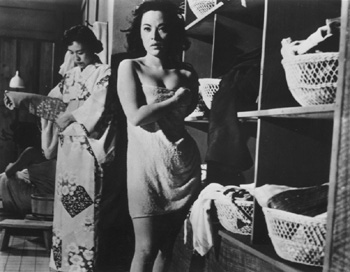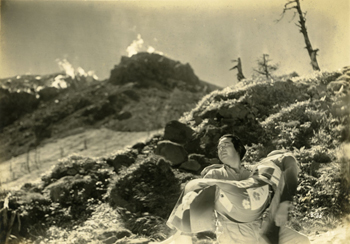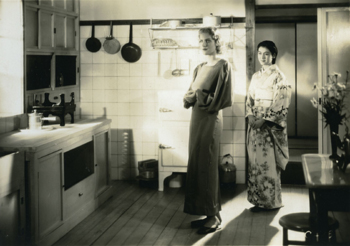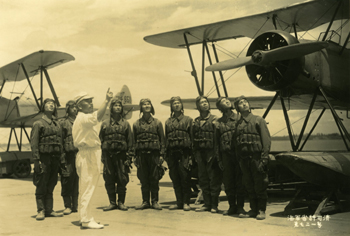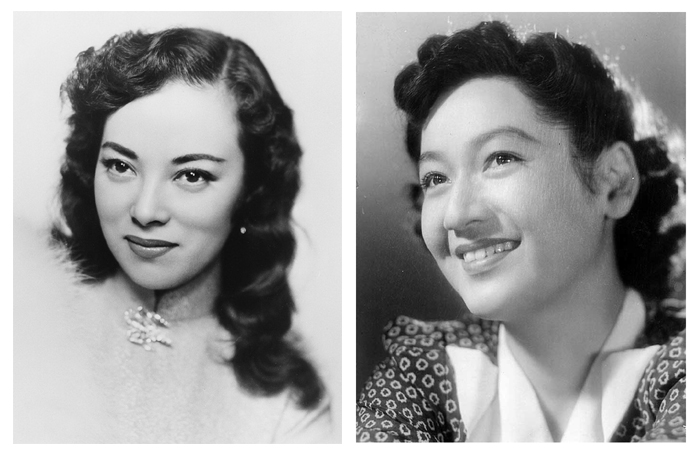 New York`s Japan Society will screen 35mm prints of war films starring two of the most powerful actresses in Japanese cinema, Shirley Yamaguchi and Setsuko Hara. Photos courtesy of Japan Society. Setsuko Hara portrait © The Pacific War Photos of Pfc Glenn W. Eve.
New York`s Japan Society will screen 35mm prints of war films starring two of the most powerful actresses in Japanese cinema, Shirley Yamaguchi and Setsuko Hara. Photos courtesy of Japan Society. Setsuko Hara portrait © The Pacific War Photos of Pfc Glenn W. Eve.From WWII Propaganda to Postwar Reincarnations, Film Series Reveals How Roles of Two of Japan`s Greatest Actresses Transformed with the Nation Source: Japan Society All Film Descriptions Written by Markus Nornes Special Thanks to Shannon Jowett The Most Beautiful: The War Films of Shirley Yamaguchi & Setsuko Hara March 21-April 4, 2015, at Japan Society New York, NY -- Japan Society continues its Stories from the War series, marking the 70th anniversary of the end of WWII, with the 2015 Globus Film Series The Most Beautiful: The War Films of Shirley Yamaguchi & Setsuko Hara, Saturday March 21 through Saturday, April 4, at Japan Society.
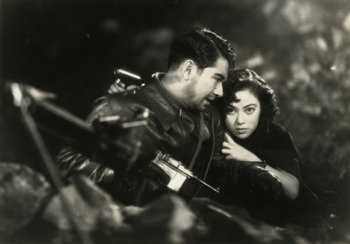 Kazuo Hasegawa and Shirley Yamaguchi (as Ri Koran) in SONG OF THE WHITE ORCHID. Photo courtesy of Japan Society. © Toho Co., Ltd.
Kazuo Hasegawa and Shirley Yamaguchi (as Ri Koran) in SONG OF THE WHITE ORCHID. Photo courtesy of Japan Society. © Toho Co., Ltd.The series title, a reference to an early Kurosawa film of the same name, pays tribute to two of the most powerful actresses in Japanese cinema: Shirley Yamaguchi (aka Pan Shuhua, Ri Koran, Li Hsianglan, Yoshiko Yamaguchi, and Yoshiko Otake) and Setsuko Hara (aka Masae Aida). Guest curator Dr. Markus Nornes, Professor of Asian Cinema at the University of Michigan, has selected nine films made before, during and after WWII that illustrate how the actresses` respective roles on the silver screen transformed along with Japan itself -- from maidens serving an empire allied with Nazi Germany to mature women walking different paths in a nation reborn after WWII. "These women have generally been considered two of the most beautiful actors in Japanese silver screen history," says Yoko Shioya, Artistic Director of Japan Society who oversees film and performing arts programming. "But this beauty has many layers of meanings when we examine how the actresses roles shifted from a time when Japan was under imperial rule to it becoming a democratic society after the war." Both Yamaguchi and Hara were born in 1920 and achieved stardom in the so-called "national policy" propaganda films of the China and Pacific. "Of the two actors, Yamaguchi led the more complicated -- even spectacular -- life," writes Nornes. Born to expatriates in a Japanese colony in Manchuria, Yamaguchi grew up fluent in both Japanese and Chinese. This skill, along with formal opera training, caught the attention of the Manchurian Motion Picture Association, who cast her as an impertinent or victimized Chinese woman in their films. After her 1938 debut, she would fast become one East Asia’s first transnational stars.
The Most Beautiful series launches March 21 with CHINA NIGHTS, the notorious 1940 propaganda film starring Yamaguchi, which is as famous for its theme song as it is infamous for the controversial alternate versions that played in Japan and China -- one of the main reasons Yamaguchi was given a death sentence and forced to flee China. Yamaguchi`s transition to postwar international stardom is arguably best represented by the series closer HOUSE OF BAMBOO, screening April 4. The acclaimed Hollywood picture directed by Samuel Fuller in 1955 will be shown in a newly struck 35mm print. Perhaps more remarkable than her cinematic transition, was the road her personal life took and her social impact after the war, discussed widely by media coverage after her death in 2014 (see obituaries from The New York Times, Variety, The Washington Post, and The Globe and Mail). "Rather than running away from history, she participated in it," says Nornes. After pursuing a career in Hong Kong, Hollywood and on Broadway, she became deeply politically active. Serving 18 years in the Diet, she was one of the first Japanese politicians to renounce imperialism. She acknowledged and renounced war crimes, and publicly apologized for her unwitting wartime misalliance. Setsuko Hara is well-known to fans of Japanese cinema primarily from her work with Ozu and Kurosawa from the late ’40s through the ’60s, but many are unaware of her early roles in Japanese propaganda films. She debuted in 1936 at age 15 "as a cinematic paragon of youthful womanhood," writes Nornes, often playing characters like the pure and innocent daughter supporting young men being deployed to war. The persona was "tweaked into the `eternal virgin` after 1945," when she often played the "new" Japanese woman with a bright future or that of a more conservative and diligent daughter or wife.
The film that launched Hara to stardom was the 1937 Japanese-German co-production THE NEW EARTH, screening March 24, which anticipated the allying of the two nations. In stark contrast is her appearance less than a decade later in Akira Kurosawa`s overlooked 1946 masterpiece NO REGRETS FOR OUR YOUTH, screening April 3, a film that forcefully rejects fascism and celebrates democracy. Hara`s postwar career was short-lived. She retired from film and public view in 1963 and is said to be living in Kamakura region of Japan. Little is known about her current condition. Rounding out the series are the Yamaguchi vehicles SONG OF THE WHITE ORCHID (1939, dir. Kunio Watanabe), screening March 27, BELL OF SAYON (1943, dir. Hiroshi Shimizu), screening March 28, and SCANDAL (1950, dir. Akira Kurosawa), screening March 31; and the Hara vehicles TOWARD THE DECISIVE BATTLE IN THE SKY (1943, dir. Kunio Watanabe), screening March 28, and LATE SPRING (1949, dir. Yasujiro Ozu), screening April 4. With one exception, all films are being shown on 35mm prints. The propaganda films are rarely screened publicly and largely unavailable within the United States. Many of these films will be projected with live subtitling created in-house at Japan Society. Among special events during the series, China Nights (March 21) will be followed by a reception; scholar and film historian Inuhiko Yomota will provide a lecture on the life of Shirley Yamaguchi (March 28); Darrell Davis, Visiting Professor, NYU Cinema Studies, introduces Bell of Sayon (March 28); Paul Anderer, Mack Professor of Humanities and Professor of Japanese Literature, Columbia University, introduces No Regrets for Our Youth (April 3); and Ian Buruma, Paul W. Williams Professor of Human Rights and Journalism, Bard College, introduces House of Bamboo (April 4). Tickets: $12/$9 Japan Society members, seniors/students, except $15/$12 for the opening night screening of China Nights with reception. Tickets are available at japansociety.org, in person at Box Office, or by calling 212-715-1258. Patrons who purchase three tickets for at least three different films receive $2 off each ticket when purchased together. Special offer available only at the Box Office or by telephone; offer not available online. SCREENING SCHEDULE & FILM DESCRIPTIONS
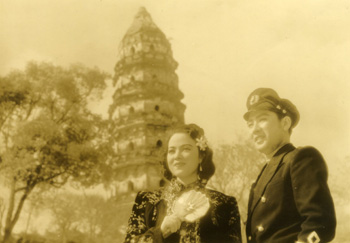 Shirley Yamaguchi (as Ri Koran) and Kazuo Hasegawa in CHINA NIGHTS. Photo courtesy of Japan Society. © Toho Co., Ltd.
Shirley Yamaguchi (as Ri Koran) and Kazuo Hasegawa in CHINA NIGHTS. Photo courtesy of Japan Society. © Toho Co., Ltd.CHINA NIGHTS (????, Shina no Yoru) Saturday, March 21 at 7 PM **Followed by a reception. 1940, 126 min., 35mm, b&w, in Japanese with live English subtitles. Directed by Osamu Fushimizu. With Shirley Yamaguchi (as Ri Koran), Kazuo Hasegawa. CHINA NIGHTS was the second film in what came to be known as the "Continental Trilogy," along with SONG OF THE WHITE ORCHID and VOW IN THE DESERT. All three are national allegories centered on a romance between the Japanese star Kazuo Hasegawa and Shirley Yamaguchi (Ri Koran). Like its predecessor, the film centers on misunderstanding, mistrust and the redemptive power of romance. Yamaguchi plays a rebellious young woman, who comes around to appreciate the Japanese through Hasegawa’s tough love. In the famous turning point of the film, Yamaguchi turns love-struck with Hasegawa (and awestruck by Japanese goodwill) with a slap in the face. While this is a convention of Japanese prewar cinema, the allegorical nature of this project led to quite different interpretations in Japan and China. Despite this bit of cultural blindness on the part of the Japanese filmmakers, they cleverly crafted different dénouements for the film; in the Chinese version the lovers live happily ever after, and in the Japanese version Yamaguchi commits suicide. Not surprisingly, the Chinese saw the film as a slap in the face. CHINA NIGHTS was one of the main reasons for Yamaguchi’s death sentence after the war. Print courtesy of National Film Center, The National Museum of Modern Art, Tokyo. Kimonos on display during Opening Night reception courtesy of a private collector from Osaka in cooperation with Japanese Culture & Style, Rinko Kimino, Globus Washitsu, and Tea-Whisk.
THE NEW EARTH (????, Atarashiki Tsuchi) Tuesday, March 24 at 7 PM 1937, 114 min., 35mm, b&w, in Japanese with English subtitles. Directed by Arnold Fanck and Mansaku Itami. With Setsuko Hara, Isamu Kosugi, Ruth Eweler, Sessue Hayakawa. Setsuko Hara caught the eye of visiting Nazi film director Arnold Fanck the year after her 1936 debut, while she was performing for Mansaku Itami’s KOCHIYAMA SOSHUN. The two directors cast her for the lead in their German-Japanese co-production of THE NEW EARTH. The new earth in question is Manchuria, which Japan had seized in 1931 and was aggressively colonizing at the time of production. For the Nazis’ part, the film was designed to uplift the image of the non-white Japanese on the eve of the 1936 Anti-Comintern Pact that made the two countries allies (one of the German diplomats working on the agreement traveled undercover with the film crew). A Japanese man returns from Europe and filled with admiration for European culture... and women, as he rejects marriage with Setsuko Hara. Her father, played by Sessue Hayakawa, brings him around to a re-appreciation of both Hara and Japanese culture. The two marry and move to Manchuria as settlers. Itami and Fanck did not see eye to eye, releasing their own individual edits of the film; Fanck’s was released under the title THE DAUGHTER OF THE SAMURAI (Die Tochter des Samurai) and Hara attended the German premiere with an admiring Adolph Hitler. Japan Society is showing the Itami version. This film catapulted Hara to instant movie stardom and she became a mainstay of the Japanese war film. Print courtesy of National Film Center, The National Museum of Modern Art, Tokyo.
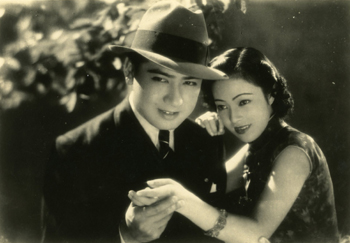 Kazuo Hasegawa and Shirley Yamaguchi (as Ri Koran) in SONG OF THE WHITE ORCHID. Photo courtesy of Japan Society. © Toho Co., Ltd.
Kazuo Hasegawa and Shirley Yamaguchi (as Ri Koran) in SONG OF THE WHITE ORCHID. Photo courtesy of Japan Society. © Toho Co., Ltd.SONG OF THE WHITE ORCHID (????, Byakuran no Uta) Friday, March 27 at 7 PM 1939, 102 min., 35mm, b&w, in Japanese with live English subtitles. Directed by Kunio Watanabe. With Shirley Yamaguchi (as Ri Koran), Kazuo Hasegawa. SONG OF THE WHITE ORCHID was a co-production of Toho and Mantetsu, the railway that served the colonial region of Manchuria, and the first film in the Kazuo Hasegawa/Shirley Yamaguchi (Ri Koran) "Continental Trilogy." Handsome Hasegawa (representing Japan) runs up against an impertinent Yamaguchi (representing the continent); not surprisingly, in the course of the film the woman comes around and realizes the benevolent intentions of the Japanese. In SONG OF THE WHITE ORCHID Yamaguchi leaves Hasegawa, who plays an expatriate working for the railway, because of a misunderstanding. She joins a communist guerilla group plotting to blow up the Manchurian railway. Learning of the subterfuge that led to the misunderstanding, she renews her faith in Hasegawa -- and by extension Japan -- and tries to undermine the plot. Print courtesy of National Film Center, The National Museum of Modern Art, Tokyo.
BELL OF SAYON (?????, Sayon no Kane) Saturday, March 28 at 4:30 PM **Introduction by Darrell Davis, Visiting Professor, NYU Cinema Studies 1943, 75 min., 35mm, b&w, in Japanese with live English subtitles. Directed by Hiroshi Shimizu. With Shirley Yamaguchi (as Ri Koran), Yoshiaki Konoe, Kenji Oyama. The bell of the title was a 1941 gift to a mountain village in Taiwan by the Japanese colonial governor. It commemorated the fervent patriotic devotion (to Japan) of Sayun Hayun, a young woman who accidentally died while seeing off her Japanese teacher, who departed for the Chinese front in 1938. In yet another racial transfiguration, Shirley Yamaguchi (Ri Koran) takes the title role of the girl, who happens to be an aboriginal (the original inhabitants of the island, doubly colonized by first the Chinese and then the Japanese). The film -- adaptation of a hit propaganda song -- was directed by Hiroshi Shimizu, a filmmaker known for his location-based realism and powerful direction of children. Shimizu deploys all these elements to the end of assimilating Taiwanese aboriginals and Chinese into Japanese imperial subjectivity.
TOWARD THE DECISIVE BATTLE IN THE SKY (??????, Kessen no Oozora e) Saturday, March 28 at 7 PM 1943, 81 min., 35mm, b&w, in Japanese with live English subtitles. Directed by Kunio Watanabe. With Setsuko Hara, Minoru Takada, Yataro Kurokawa, Masaru Kodaka, Yuriko Hanabusa. TOWARD THE DECISIVE BATTLE IN THE SKY describes the challenging training of young boys in the Yokaren, a program feeding new pilots into the Army and Navy. By the time of the filming, the pressure of the war had led the government to shorten the training and expand the age range of the recruits. Yokaren was highly selective, and thus an object of great fascination and desire for boys and young men. In this Navy-sponsored film, Setsuko Hara plays the daughter of a family that often entertains recruits on their days off -- a surrogate sister to many trainees. Her fragile younger brother aspires to join the program, but is rejected. With perseverance and much support from Hara and their mother, he surmounts his weaknesses and becomes a flier. Print courtesy of National Film Center, The National Museum of Modern Art, Tokyo.
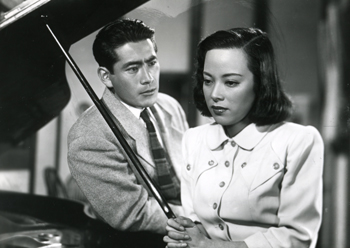 Toshiro Mifune and Shirley Yamaguchi (as Yoshiko Yamaguchi) in Akira Kurosawa`s SCANDAL. Photo courtesy of Japan Society. © 1950 Shochiku Co., Ltd.
Toshiro Mifune and Shirley Yamaguchi (as Yoshiko Yamaguchi) in Akira Kurosawa`s SCANDAL. Photo courtesy of Japan Society. © 1950 Shochiku Co., Ltd.SCANDAL (??, Shubun aka Sukyandaru) Tuesday, March 31 at 7 PM **Co-presented with Japan Foundation 1950, 105 min., 35mm, b&w, in Japanese with English subtitles. Directed by Akira Kurosawa. With Shirley Yamaguchi (as Yoshiko Yamaguchi), Toshiro Mifune, Takashi Shimura, Yoko Katsuragi, Noriko Sengoku, Sakae Ozawa, Shinichi Himori. While Akira Kurosawa is appreciated mainly for his samurai films, he worked in a wide variety of genres. SCANDAL was shot and released the same year as RASHOMON, but it never attracted much attention until recent decades with its release on video. A rough combination of sentimental melodrama and comedy, the film skewers the growing pop culture press of the Occupation era. Shirley Yamaguchi (Yoshiko Yamaguchi) plays a beautiful concert singer, who happens to meet an artist -- a debonair Toshiro Mifune -- in a hot springs area. Stalked by a scandal rag, their chance meeting is mistaken for a tryst and soon becomes the center of a highly publicized legal feud.
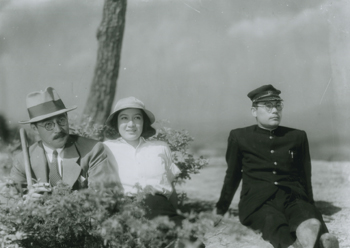 Denjiro Okochi Setsuko Hara and Susumu Fujita in Kurosawa`s NO REGRETS FOR OUR YOUTH. Photo courtesy of Japan Society. © Toho Co., Ltd.
Denjiro Okochi Setsuko Hara and Susumu Fujita in Kurosawa`s NO REGRETS FOR OUR YOUTH. Photo courtesy of Japan Society. © Toho Co., Ltd.NO REGRETS FOR OUR YOUTH (????????, Waga Seishun ni Kuinashi) Friday, April 3 at 7 PM **Co-presented with Japan Foundation **Introduction by Paul Anderer, Mack Professor of Humanities and Professor of Japanese Literature, Columbia University 1946, 110 min., 35mm, b&w, in Japanese with English subtitles. Directed by Akira Kurosawa. With Setsuko Hara, Susumu Fujita, Denjiro Okochi, Haruko Sugimura, Eiko Miyoshi, Aritake Kono. Akira Kurosawa’s first postwar film is a powerful denunciation of fascism and a hopeful celebration of democracy set amidst the political violence of the late 1930s. The film’s political stance hinges on the growth of Yukie Yagihara, the daughter of a liberal college professor. She is caught between two potential lovers, one a timid liberal and the other a militant radical bent on action. Strong willed and equally opposed to the rising militarism of Japan, she chooses the latter and suffers greatly for it. When the war ends, she devotes herself with equal passion to democratizing Japan. The film is part and parcel of the Occupation’s efforts to promote democratic ideals, including anti-militarism, women’s rights and agrarian reform. Considering Setsuko Hara’s quite real contribution to the militarization of Japanese popular culture and the aestheticization of the beautiful death, Kurosawa’s casting is more than a little ironic. However, Hara’s portrayal of Yukie infuses the film with a curious ambivalence that makes the film’s politics less than straightforward -- a point of debate for critics ever since the film was released.
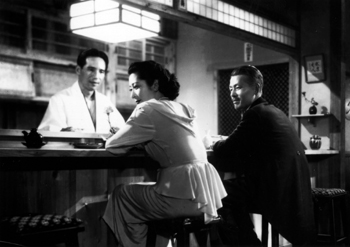 Setsuko Hara and Chishu Ryu in Yasujiro Ozu`s LATE SPRING. Photo courtesy of Japan Society. © 1949 Shochiku Co., Ltd.
Setsuko Hara and Chishu Ryu in Yasujiro Ozu`s LATE SPRING. Photo courtesy of Japan Society. © 1949 Shochiku Co., Ltd.LATE SPRING (??, Banshun) Saturday, April 4 at 4 PM 1949, 108 min., 35mm, b&w, in Japanese with English subtitles. Directed by Yasujiro Ozu. With Setsuko Hara, Chishu Ryu, Yumeji Tsukioka, Haruko Sugimura, Hohi Aoki. Often considered Yasujiro Ozu’s postwar masterpiece, the film also cemented Setsuko Hara’s reputation as the “eternal virgin.” Here she plays the daughter of a widower who is intent on marrying her away as soon as possible. LATE SPRING was produced midway through the U.S. Occupation, and as such it had to toe certain lines. For example, its treatment of an essentially arranged marriage had to be finessed, and a reference to the rubble of Tokyo is reduced to a reference of its dustiness. Hara also appeared in Ozu’s 1960 LATE AUTUMN, a remake of LATE SPRING where she takes the place of the father. It was mainly through these collaborations with Ozu that Hara cleansed her wartime record and presented herself as a paragon of democratization. “LATE SPRING is one of the best two or three films Ozu ever made…” – Roger Ebert
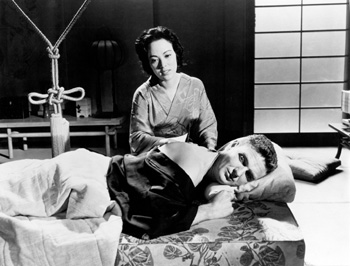 Shirley Yamaguchi and Robert Stack in HOUSE OF BAMBOO. Photo courtesy of Japan Society. © 1955 20th Century Fox
Shirley Yamaguchi and Robert Stack in HOUSE OF BAMBOO. Photo courtesy of Japan Society. © 1955 20th Century FoxHOUSE OF BAMBOO Saturday, April 4 at 7 PM ** Introduction by Ian Buruma, Paul W. Williams Professor of Human Rights and Journalism, Bard College 1955, 102 min., 35mm, color, in English and Japanese with English subtitles. Directed by Samuel Fuller. With Shirley Yamaguchi, Robert Ryan, Robert Stack, Cameron Mitchell, Sessue Hayakawa. A typically tough thriller by Samuel Fuller. Despite its traffic in Cinemascopic stereotype, HOUSE OF BAMBOO remains one of the best American films shot in Japan. In the words of the trailer, Shirley Yamaguchi plays a “geisha girl who gambled her life for a man.” This is a loose remake of THE STREET WITH NO NAME (1948), co-starring Robert Ryan, and Sessue Hayakawa. Robert Stack plays an undercover agent infiltrating a ruthless gang led by Ryan. Along the way, he falls in love with Yamaguchi. She lost a lover at the hands of the gang and quickly becomes Stack’s “kimono.” The spectacular scenery of a Tokyo poised between total war and the Olympics vie for attention from the noir-ish and fast-paced intrigue. “5 out of 5 stars... a masterpiece that pinpoints the sublime in Fuller`s sensationalism and earns every inch of its widescreen real estate.” – David Fear, Time Out New York RELATED LECTURE An Actress with a Thousand Names: Inuhiko Yomota on Shirley Yamaguchi Saturday, March 28 at 3 PM, runs one hour. **FREE with the purchase of a ticket to any film in the series. Seating is limited on a “first-come, first-served” basis. Shirley Yamaguchi, who went by many names in her long, accomplished lifetime, remains one of the most enigmatic figures in Japanese film history. From her beginning as a Manchurian-born actress and entertainer to her tenure in Japanese politics, she led an extraordinary life marked by mystery and self-rediscovery amidst the most turbulent events of the 20th century. Yamaguchi’s multi-faceted legacy will be explored through a lecture and Q&A session by Inuhiko Yomota, a Japanese film historian, comparative literature scholar and the author of numerous books including Ri Koran to Hara Setsuko (Tokyo, Iwanami Shoten; 2011). Lecturer Inuhiko Yomota writes about Shirley Yamaguchi: “During her very long lifetime of 92 years, she changed her name many times. She was Yoshiko Yamaguchi, Ri Koran, Li Xianglan, Shirley Yamaguchi, Yoshiko Otaka and her Arabic name was Jamira. It was not just her name either. During her life, she changed her languages, her jobs, her husbands, her boyfriends, her nationalities and her political ideologies. Nobody seemed to know whether she was Chinese, Korean or Japanese. Ri Koran (1920-2014) was an actress for 18 years and then spent the next 18 years as a politician. As an actress, beginning in Manchuria, she went on to work in Tokyo, Shanghai, Hong Kong, Taiwan, Korea and even Hollywood. With her striking beauty similar to that of Danielle Darrieux and her pitch-perfect, beautiful soprano voice, she drove audiences to a frenzy. She later deeply regretted her appearance as a young girl in melodrama films that had hurt the Chinese people under Japanese occupation. From this self-critical realization, her second life began. "As a politician, she became heavily involved in aiding Palestinian refugees as well as in the problems related to the compensation and apology towards comfort women. She strongly opposed the Prime Minister`s visit to Yasukuni shrine and was awarded for her made-for-television documentary about Palestine and the Japanese Red Army. Her life was adapted into an antiwar musical which traveled around East Asia and praised for its antiwar sentiments. "Once, she said to me, ‘my biggest secret was that I am Japanese. Now that this secret is out, I no longer have any secrets. So feel free to ask me anything.’ She had a lightness in her voice. It was a cheer that could only be admitted by a person who had survived the nightmare that was 20th Century.” Participant Bios: Markus Nornes is Professor of Asian Cinema at the University of Michigan. His latest book is The Pink Book: the Japanese Eroduction and its Contexts. His previous books include A Research Guide to Japanese Cinema Studies, Cinema Babel: Translating Global Cinema, Forest of Pressure: Ogawa Shinsuke and Postwar Japanese Documentary Film and Japanese Documentary Film: From the Meiji Era to Hiroshima. He co-edited Japan-American Film Wars, In Praise of Film Studies, and many film festival retrospective catalogs. Professor Nornes was also a coordinator for the Yamagata International Documentary Film Festival from 1990 to 2005, where he programmed major retrospectives such as Japan-America Film Wars, In Our Own Eyes—Indigenous People`s Film and Video Festival, and Den`ei Nana Henge: Seven Transfigurations in Electric Shadows. More at umich.academia.edu/MarkusNornes. Inuhiko Yomota is a Japanese film historian, a comparative literature scholar and the author of numerous books include Ri Koran to Hara Setsuko (Tokyo, Iwanami. 2011). Read an interview at midnighteye.com. Darrell Davis received his PhD from Wisconsin, writing a dissertation on prewar Japanese films. He published this study for Columbia University Press, Picturing Japaneseness (1996). He lives in Hong Kong, doing research and teaching on East Asian screen industries. Ian Buruma studied Chinese literature at Leiden University and Japanese film at Nihon University in Tokyo. He has held a number of editorial and academic positions, and has contributed numerous articles to the New York Review of Books. He has held fellowships at the Woodrow Wilson International Center for Scholars, Washington, D.C and St Antony`s College, Oxford. In 2003 he became Luce Professor of Democracy, Human Rights & Journalism at Bard College, New York, where he now resides. He is the author of many books including China Nights, a novel about Shirley Yamaguchi’s life. SCHEDULE AT-A-GLANCE Saturday, March 21 7:00 CHINA NIGHTS Tuesday, March 24 7:00 THE NEW EARTH Friday, March 27 7:00 SONG OF THE WHITE ORCHID Saturday, March 28 3:00 Inuhiko Yomota lecture 4:30 BELL OF SAYON 7:00 TOWARD THE DECISIVE BATTLE IN THE SKY Tuesday, March 31 7:00 SCANDAL Friday, April 3 7:00 NO REGRETS FOR OUR YOUTH Saturday, April 4 4:00 LATE SPRING 7:00 HOUSE OF BAMBOO STORIES FROM THE WAR SERIES Marking the 70th anniversary of the end of WWII, Japan Society`s Stories from the War series encompasses theater performances, film screenings, lectures, panels, themed language classes, and educational opportunities for young people. Programming explores history and considers challenging issues that the U.S. and Japan faced surrounding WWII. Through a range of perspectives and narratives, Stories from the War touches on women`s issues, patriotism, life during war, nuclear weapons, propaganda, nationalism, Japanese-American internment, selective memory, democracy and more. The series also shows how contemporary Japanese and American artists and scholars are still much influenced by WWII. In addition to The Most Beautiful film series, upcoming Stories form the War programming includes the performances Michiko Godai’s Yokohama Rosa (April 25 &26) and New and Traditional Noh: Holy Mother in Nagasaki & Kiyotsune (May 14-16) and related language workshops; 70 Years Later: Reflecting on the Atomic Bombings with Survivors & President Truman’s Grandson (April 28) and Call of Duty: Propaganda & the Arts Summer Workshop (August 17–20) for high school students; and the talks Meet the Author: Listening to Stone: The Art and Life of Isamu Noguchi by Hayden Herrera (April 21) and The Importance of History: Yukio Okamoto on Addressing Japan’s Past (April 6). Past events included the North American tour of Miwa Yanagi’s Zero Hour: Tokyo Rose`s Last Tape (January 29-31), Meet the Author: An Evening with Julie Otsuka, When the Emperor Was Divine (February 19), and Changing Memories of World War II, 70 Years after 1945 (February 26). The Japan Society Film Program offers a diverse selection of Japanese films, from classics to contemporary independent productions. Its aim is to entertain, educate and support activities in the Society`s arts & culture programs. The Film Program has included retrospectives of great directors, thematic series and many U.S. premieres. Some original film series curated by Japan Society have traveled to other U.S. venues in tours organized by the Film Program. For more visit japansociety.org. Founded in 1907, Japan Society is a multidisciplinary hub for global leaders, artists, scholars, educators, and English and Japanese-speaking audiences. At the Society, more than 100 events each year feature sophisticated, topically relevant presentations of Japanese art and culture and open, critical dialogue on issues of vital importance to the U.S., Japan and East Asia. An American nonprofit, nonpolitical organization, the Society cultivates a constructive, resonant and dynamic relationship between the people of the U.S. and Japan. Japan Society is located at 333 East 47th Street between First and Second avenues (accessible by the 4/5/6 and 7 subway at Grand Central or the E and M subway at Lexington Avenue). For more information, call 212-832-1155 or visit japansociety.org. The Most Beautiful: The War Films of Shirley Yamaguchi & Setsuko Hara is made possible through the generous support of The Globus Family. Stories from the War is supported by a generous grant from the Japan-United States Friendship Commission. Society`s Film Program is generously supported by the Lila Wallace-Reader`s Digest Endowment Fund. Additional season support is provided by The Globus Family, Mr. Kenneth A. Cowin, Mr. and Mrs. Omar H. Al-Farisi, Mr. and Mrs. Jeffrey Catanzaro, Laurel Gonsalves, David S. Howe, James Read Levy, Geoff Matters, and Dr. Tatsuji Namb


